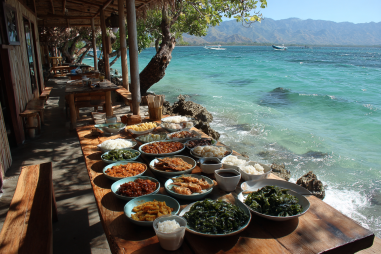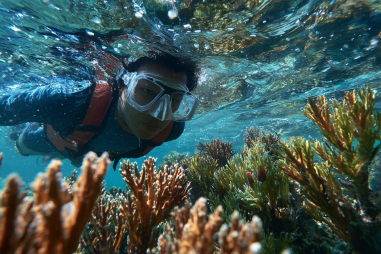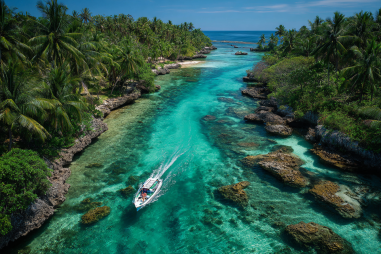Nestled in the heart of the Philippines, Apo Island is a paradise for nature lovers and adventure seekers alike. Renowned for its vibrant coral reefs and crystal-clear waters, the island also boasts a variety of hiking trails that reveal its lush tropical interior and stunning ocean vistas. Whether you’re an experienced hiker or just looking for a peaceful stroll surrounded by nature, Apo Island’s trails offer a perfect blend of scenic views, diverse wildlife, and tranquil forest escapes. This guide will walk you through the best hiking trails on Apo Island, what to expect, and how to make the most of your hiking adventure here.
Exploring Hiking Options on Apo Island
Apo Island may be small, covering roughly 74 hectares, but its natural terrain is surprisingly varied. The island features gentle hills, rocky coastlines, and verdant woodlands that make hiking an enjoyable activity for visitors. You can choose from short, easy trails ideal for families or longer and more challenging routes that lead to breathtaking viewpoints overlooking the ocean.
Because the island is well known primarily for snorkeling and diving, hiking provides a complementary way to experience its beauty above water. Many of the trails are well-maintained and signposted, making it easy for self-explorers to navigate. Additionally, guided hikes are available for those who want a more informative journey, complete with insights into the island’s ecology and culture.
Popular Trails and Their Difficulty Levels
Several key trails stand out on Apo Island, each offering unique features and varying levels of difficulty. Here are some of the most favored routes:
- Lighthouse Trail: This is arguably the most popular hike on the island. Starting near the main village, it takes about 30 to 45 minutes to reach the lighthouse perched on a hilltop. The trail is moderately challenging with some steep but manageable inclines. The reward is a panoramic view of the island’s shoreline and the vast ocean beyond.
- Marine Sanctuary Overlook Trail: Ideal for a shorter walk, this trail offers a relatively easy path leading to a viewpoint overlooking the marine sanctuary waters. It’s perfect for those who want a brief escape and amazing photo opportunities without strenuous effort.
- Forest Loop Trail: For hikers interested in nature immersion, this trail winds through dense tropical forest. It is a moderate hike with uneven footing and occasional rocky sections. Along this loop, hikers can enjoy cool shade and observe the island’s flora and fauna.
- Summit Trail: The most physically demanding route, the summit trail leads to the highest point on the island. It offers expansive views of Apo Island, Negros, and the surrounding seas. This trail is recommended for experienced hikers comfortable with steep climbs and rough terrain.
Points of Interest Along the Hikes
Apo Island’s trails are dotted with interesting landmarks and natural highlights:
- The Apo Island Lighthouse: A historic beacon guiding fishermen and boats, the lighthouse is a charming spot to rest and take in the view.
- Coral Gardens Viewpoints: From certain vantages along the trails, you can look down onto vibrant coral formations underwater, visible thanks to the clear water surrounding the island.
- Local Fishing Villages: Walking near the island’s small villages provides a glimpse into the everyday life of Apo Island’s community and their traditional fishing methods.
- Rock Formations and Beach Coves: Along some trails, unique rock formations and quiet beaches invite hikers to explore and maybe even cool off with a swim.
Wildlife and Plant Species to Observe
One of the delights of hiking Apo Island is encountering its rich biodiversity. The island’s ecosystems support a variety of flora and fauna that make every hike memorable:
- Tropical Birds: Watch for colorful species such as kingfishers, bulbuls, and parrots flitting among the trees.
- Reptiles and Amphibians: Lizards and frogs are common along the trails, especially near wetter parts of the forest.
- Butterflies and Insects: Vibrant butterflies and unique insects can often be seen on plants and flowers.
- Plant Life: The trails showcase native palms, ferns, and flowering trees, alongside older growth forest that sustains the island’s environmental health.
Remember to observe wildlife respectfully without disturbing their natural habitats.
Tips for Safe Hiking and Gear Recommendations
To enjoy your Apo Island hiking experience safely and comfortably, here are some practical tips and gear advice:
- Footwear: Wear sturdy, closed-toe hiking shoes or trail sandals with good grip to handle uneven terrain and possible slippery spots.
- Clothing: Lightweight, breathable fabrics are best. Long sleeves and pants help protect against insect bites and sun exposure.
- Sun Protection: Bring a hat, sunglasses, and sunscreen, especially on exposed trails like the Lighthouse Trail.
- Hydration: Carry enough water to stay hydrated during your hike, particularly on warmer days.
- First Aid: A small first aid kit can be useful for minor scratches or insect bites.
- Guide or Map: If going solo, have a local map or consider joining a guided hike for safety and local insights.
- Respect the Environment: Stay on marked trails, avoid littering, and leave nature as you found it.
Best Times to Hike for Weather and Scenery
Apo Island enjoys a tropical climate, but choosing the best time to hike can greatly enhance your experience. The dry season, spanning from November to April, is ideal for trekking due to lower rainfall and sunnier days. Early mornings and late afternoons offer cooler temperatures and softer light, perfect for comfortable hiking and stunning photography.
The rainy season (May to October) brings lush greenery but also slippery paths and occasional downpours, so if you hike during these months, be prepared for changing conditions. Sunrise or sunset hikes, especially to the lighthouse or summit, can provide spectacular colors over the ocean and island landscapes.
Guided Hikes vs. Self-Exploration
Whether you choose a guided hike or prefer to explore Apo Island’s trails independently depends on your preferences and experience level.
Guided hikes offer several benefits:
- Local guides provide valuable knowledge about the island’s history, ecology, and culture.
- They ensure you stay on safe trails and avoid getting lost.
- Guides can point out wildlife and plant species that you might miss on your own.
Self-exploration appeals to those who enjoy setting their own pace and spending more time in quiet contemplation. With accessible trail markers and small area coverage, Apo Island is manageable for confident hikers venturing solo or in small groups. Just be sure to inform someone about your plans and carry a map or GPS device.
Many visitors combine both approaches – taking a guided hike on their first day to become familiar with the terrain, then returning to the trails on their own schedule.
Embracing the Island’s Beauty on Foot
Hiking on Apo Island is a rewarding way to connect with its spectacular natural scenery and tranquil atmosphere. From the sweeping ocean views atop the lighthouse to the serene forest trails alive with bird songs and tropical greenery, each step brings new discoveries. Whether you’re here for a quick scenic walk or a more adventurous trek, the island’s trails promise peaceful escapes, memorable wildlife encounters, and a deeper appreciation for this slice of paradise.
So lace up your hiking shoes, pack your essentials, and set out to explore Apo Island’s hiking trails—where every path tells a story framed by breathtaking ocean views and lush tropical splendor.







